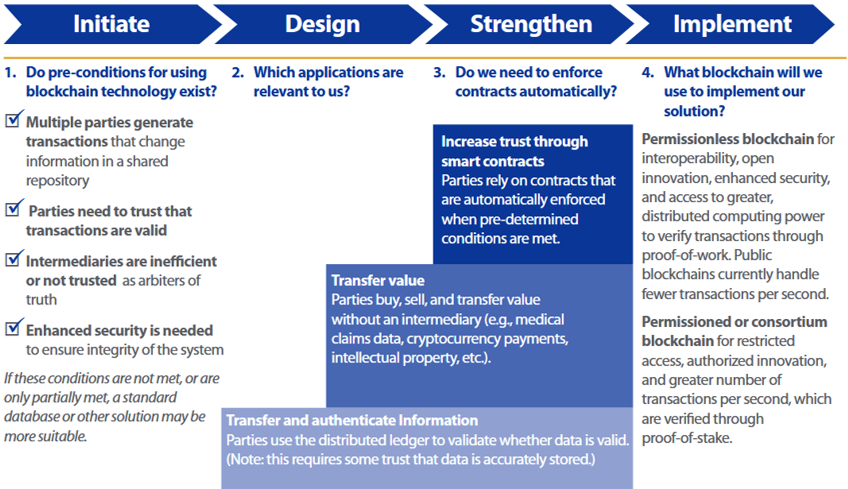
health
Towards a healthy development of blockchain?
Blockchain is a digital ledger technology that can securely maintain continuously growing lists of data records and transactions and could have a pivotal impact on the transformation of healthcare.
Initially, it was created to provide a distributed ledger of financial transactions free from the traditional ties between central banks, credit companies, or other financial institution. The technology developed gradually and rapidly extended to the legal processing of transactions as well as more technical manufacturing processes in several industries.
| BITCOIN TRANSACTION DATA
|
HEALTHCARE TRANSACTION DATA
|
Fig 1. Comparison of financial and healthcare blockchains (Ivan, 2016, Figure 3)
Blockchain will have valuable applications in the health sector. It could facilitate the storage and administration of patients’ records and foster good institutional governance while addressing connectivity and security issues between medical institutions. For patients, it could enable wide access to one’s health record while providing high privacy and traceability guarantees.
 Fig. 2. Blockchain uses cases in healthcare (www.healthit.gov)
Fig. 2. Blockchain uses cases in healthcare (www.healthit.gov)
Blockchain is a digital ledger technology that can securely maintain continuously growing lists of data records and transactions
opportunities for both patients and health practitioners
Blockchain presents numerous advantages for the health sector.
- Better care: Boosting the interoperability of medical databases could prove to be one of the most beneficial step changes in the health sector. Blockchain can turn this promise into a reality. For medical providers, such interoperability can help to improve access to medical records, imaging archives, and prescription databases.For patients, blockchain technology allows them to access their medical records more securely. Furthermore, given that one’s medical history is a pillar of successful treatment, blockchain technology can dramatically improve healthcare by providing longitudinal healthcare records. Blockchain can link patient records securely and make them accessible across non-affiliated provider organisations to improve care coordination. Such quality data could boost more tailor-made treatments, customised according to the patient’s singular spectrum of healthcare records.Last but not least, the ability to verify the authenticity of drugs at the point of dispensing (e.g. community or hospital pharmacy) is an example of a cross-sectoral use of blockchains with the pharmaceutical industry. Drug verification could also enhance the quality of healthcare.
- Cost-effectiveness: By using a ‘smart contract’ structure, blockchain can help seamlessly adjudicate patients’ health claims and payers’ payments (reimbursements) for a more cost-efficient process.At the same time, blockchain can protect against fraud. The immutability of records is a well-known feature of blockchains. They run on networks made available by personal computers (or other devices), and multiple devices can hold the same file. If someone tries to alter a specific record—for example, to erase a medical test result or change the amount of a direct deposit to an account—the file is immediately flagged as potentially fraudulent.As a general advantage also for other sectors, blockchain facilitates supply chain management. In the health sector, blockchain could enhance contract management and reduce costs by enabling real-time contract tracking and execution.
the challenges ahead
Several challenges call for responses before the complete adoption of blockchain technologies in healthcare.
- Trustworthy governance vs time and money: Blockchain technology in healthcare can develop through ecosystems created by different partners sharing and exchanging health data. To operate such an exchange, partners will need to agree on the ecosystems’ operational governance and the control of admin rights. Partners will also need to manage the changes that this technology will bring to roles and processes. Building up and agreeing such a trustworthy governance structure could take time and may prove costly.
- Interoperability vs patented applications: As described above, interoperability is one of the main advantages of blockchains. Nevertheless, copyright issues may stand in the way of facilitating greater interoperability. Indeed, most blockchain applications will be proprietary, which could jeopardise the creation of an open blockchain infrastructure.
- Barriers to data sharing: Blockchain technology can solve some of the challenges faced by health data access and sharing. However, there are several other challenges the technology will not answer. We must also overcome additional barriers, such as unjustified requirements for where data must be stored (data protection), lack of technical (semantic) interoperability, low data quality and reliability.
Blockchain presents numerous advantages for the health sector.
the steps towards implementation
Deloitte published a decision-making framework that helps to evaluate whether or not to consider a blockchain solution to specific challenges. The five main steps include:
- Ecosystem mapping: Public health authorities should come together to identify the needs of the industry.
- Consortium building: Authorities should create consortia to test prototypes and guide the development of new applications. Through public-private partnerships, they could join forces with creative innovators, skilled engineers and bold investors.
- Experiment design: Authorities should accumulate proofs-of-concept before rolling out new blockchain technologies. For each specific use case, authorities should involve all the stakeholders and address the full batch of transactions.
- Investment arbitrage: It is advised to start investing in short-term projects and small applications first. Such an approach could help to save billions at a national level in the long-term.
- Guidelines: Soon, authorities will need to draw up standards for blockchain transactions. Agreeing on a common set of national standards will boost endorsement of the technology. A growing number of participants will drive up the value for blockchain as an enabling technology.
 Fig. 3. Example of a blockchain technology decision framework (Deloitte, 2016)
Fig. 3. Example of a blockchain technology decision framework (Deloitte, 2016)
blockchain insights
We at Logos are therefore hoping to support and contribute to these efforts moving forward. This is the first in an ongoing series of pieces aiming to offer insights into blockchain technology and the related policies at the EU and Member State level. We hope you have enjoyed this Logos Insight on Blockchain, and we welcome further engagement and feedback on the topic.
Follow us on Twitter and Linkedin to not miss out on the lastest logos insights.
